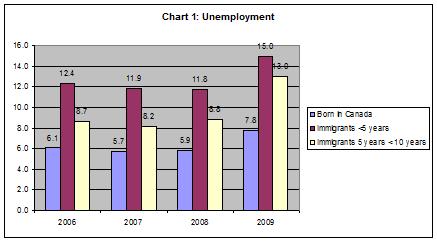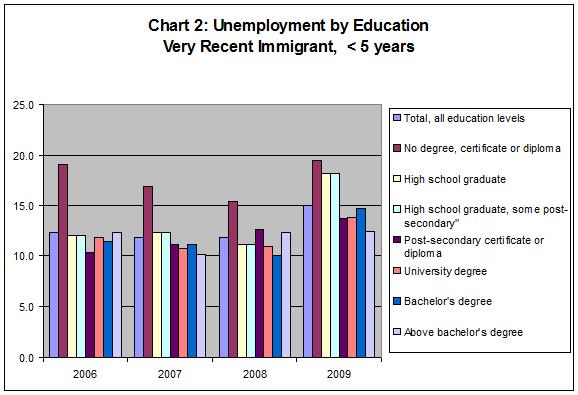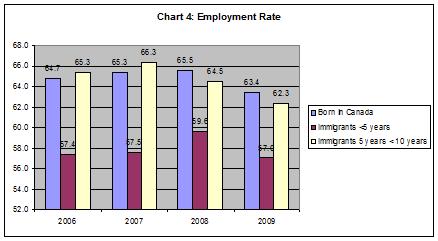GLOBAL ECONOMICS
IMMIGRATION PAPERS
Patrick Grady
Recent Immigrants Have Experienced Larger Increases in Unemployment Due to the Recession
October 3, 2010
According to a special tally of immigrants done periodically by Statistics Canada as part of the Labour Force Survey (and not published as in the past, perhaps because of the political sensitivity of the data, but still made available within government or for a fee), the recent recession hit recent immigrants much harder than other Canadians. Their unemployment rates rose to much higher levels than those born in Canada (Chart 1). The unemployment rate for very recent immigrants in the country less than 5 years rose to 15 per cent in 2009 from 11.9 per cent in 2007, a 3.1 percentage point increase. And the unemployment rate for recent immigrants in the country for between 5 and 10 years increased to 13 per cent in 2009 from 8.2 per cent in 2007, an even larger 4.8 percentage point increase. In contrast, the unemployment rate of the Canadian born only went up to 7.8 per cent in 2009 from 5.7 per cent in 2007, a 2.1 percentage point increase.

The increase in the unemployment rate among recent immigrants was greatest for those with the least education. This was true both for the most recent immigrants only in the country for less than 5 years (Chart 2), and for recent immigrants in the country for 5 to 10 years (Chart 3). But somewhat surprisingly the recent immigrants with no education who have been in the country longer experienced higher unemployment rates than very recent immigrants. For instance, those with no degree certificate or diploma had an unemployment rate of 19.5 per cent in 2009 if they were in the country less than 5 years, but 23.9 per cent if they were here for between 5 and 10 years. On the other hand, those in the country longer did significantly better if they had university degrees. However, this is small comfort as their rates of unemployment at 13.9 and 9.8 per cent respectively were several times higher than the 3.4 per cent rate experienced by the Canadian born.


The employment rate of very recent immigrants only declined slightly between 2007 and 2009, while the employment rate of recent immigrants in the country from 5 to 10 years declined sharply from 66.2 per cent in 2007 to 62.3 per cent in 2009 (Chart 4). The employment rate of recent immigrants in the country from 5 to 10 years dropped from above that of the Canadian born in 2007 to below in 2009. The employment rate of very recent immigrants in 2009 was only 57 per cent substantially below that of the Canadian born.

The participation rate of very recent immigrants actually rose significantly between 2007 and 2009 exacerbating the increase in their unemployment. In contrast, the participation rate of recent immigrants who were in the country for 5 to 10 years declined slightly, mitigating the increase in their unemployment rate. The participation rate of very recent immigrants was lower than that of the Canadian born, while that of recent immigrants in the country for 5 to 10 years was significantly higher.

The information from Statistics Canada on the unemployment rates of recent immigrants confirms the views expressed in an earlier note that recent immigrants were likely to be harder hit by the recession.
It is disappointing that in the face of these hard facts no action has yet been taken to curtail the inflow of immigrants to counter increases in unemployment as was traditionally done in the past with the “tap-on, tap-off” immigration policy. Perhaps this is in part because Statistics Canada does not report publicly on the Labour Force Survey data on the performance of immigrants in the labour market. And not only was the rate of unemployment exacerbated by the continued inflow of 250 thousand immigrants per year right through the recession, but this very large cohort of immigrants could very well have had their future employment prospects permanently damaged by entering the Canadian labour market at such an inauspicious time.